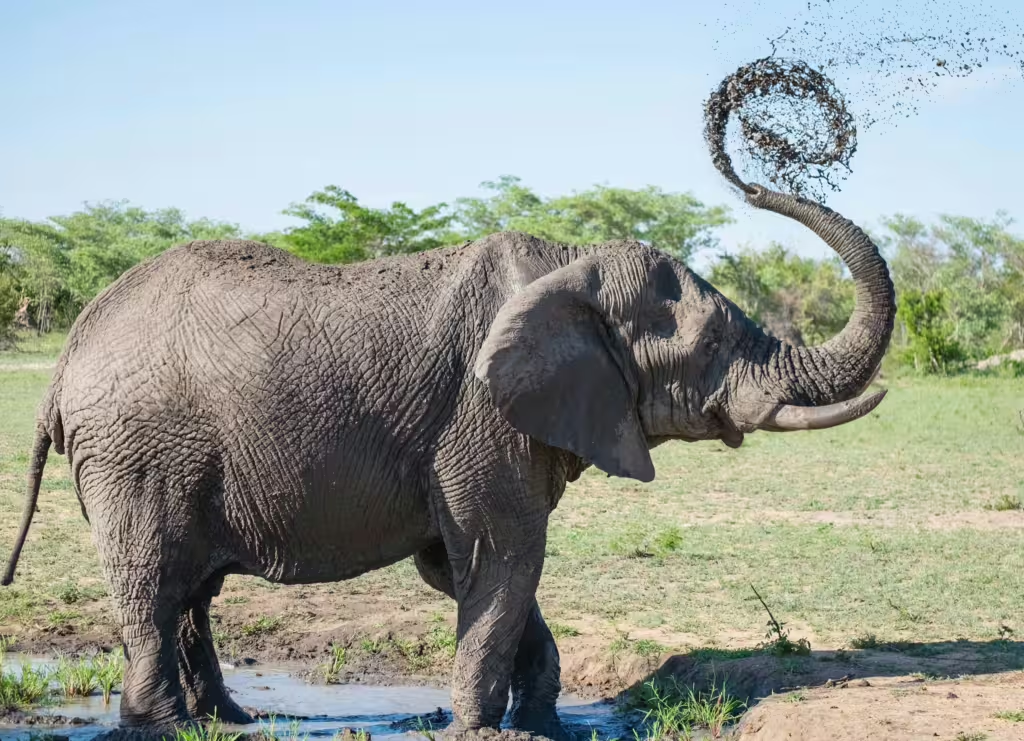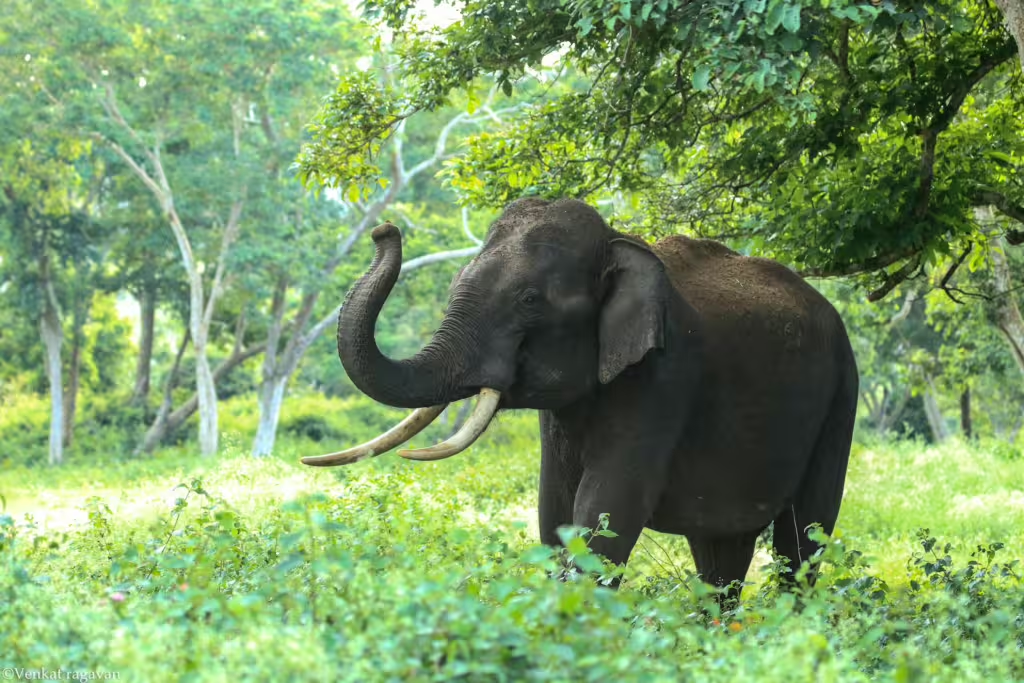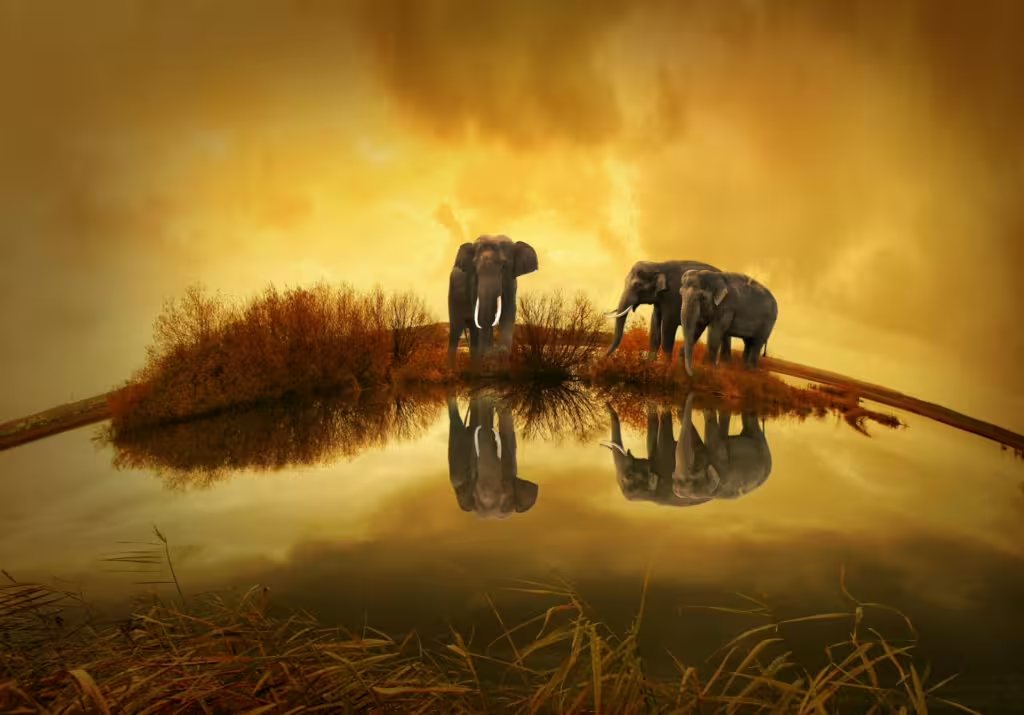If you’re not from the late 19th or very early 20th century, you may not be familiar with the word pachyderm. This word, defined as “any of various nonruminant mammals (such as an elephant, a rhinoceros, or a hippopotamus) of a former group (Pachydermata) that have hooves or nails resembling hooves and usually thick skin;” has fallen out of the vernacular over the past hundred years or so. Yet the meaning remains in Mirriam-Webster, we’re talking about elephants here.
To behold an elephant is to understand. They are truly magnificent creatures, unlike any other animal on the entire planet. And though they share some common features, habitats, ancestry, and nomenclature with hippos and rhinos, elephants are a type all their own. They are most well-known because of their size and striking features, but our understanding of zoology and the very nature of intellect have taught us much in recent centuries about their remarkable intelligence and deep social bonds.
What many folks don’t realize, even today, is that these gentle giants play a crucial role in maintaining the ecological balance of their ecosystems. They don’t just loom large in a literal sense, their mighty presence benefits countless other species that live alongside them; humans included. Sadly, elephants face more threats than most at the hands of humanity. These numerous threats from climate change, poaching, habitat destruction, and more, have placed them in very real danger of extinction.
In this article, we will travel to some of the most exotic places on the planet to explore the amazing world that elephants live in. We will learn why they are so vital to the environment, examine some of the greatest challenges they face in the modern day, and uncover fascinating facts about both African and Asian elephant subspecies.
Elephants as Environmental Engineers

Many naturalists and scientists refer to elephants as “ecosystem engineers.” This is because elephants are keystone species, which means their very existence has significant impact on the continued health of their habitat. They are giant animals, that leave a great impact both physically and figuratively wherever they tread. The services that both African and Asian elephants provide, contribute greatly to the wellness and diversity of the ecosystems they inhabit.
Forest Regeneration
It should come as no surprise that elephants eat a lot of food a day; most experts believe between 150 and 600 pounds of it, in fact. Among that enormous amount is a wide array of fruits and vegetation. As they travel, they go to the bathroom, their enormous piles of dung now containing nuts and seeds that have passed through their digestive tract. This is how elephants act as seed dispersers, which promotes plant growth across vast areas of wilderness. In African forests, elephants play a vital role in maintaining biodiversity by spreading the seeds of over 90 different species of plants.
Creating Water Sources
In more arid parts of the world, elephants can even help to create water sources. Some readers might not be aware but not all elephants dwell in the jungle. African elephants that live in the savannah and near the desert, will often use their tusks and trunks to dig for water, creating wells that provide essential hydration for other animals. These newfound water holes become lifelines for dozens of neighboring species during times of drought.
Landscape Shaping
Elephants don’t just graze at the treetops like giraffes, they push their way around the jungle as they please, knocking down trees as they go. They often do this on purpose, in order to feed on the fallen foliage. This tree-clearing opens up dense forests and creates entirely new environments in their wake, namely grasslands. Not only does this process support other herbivores like zebras and antelopes, which thrive in open areas, it helps the elephants in the long run, as well, since they also like to feed on long grasses.
Maintaining Wetlands
Wetlands are another example of essential habitats for many species all over the world. They help filter fresh water, provide homes and breeding grounds for migrating birds, and maintain biodiversity wherever they are found. Asian elephants, especially those in Sri Lanka and India, help maintain wetlands like these. They accomplish this by trampling vegetation, which prevents overgrowth and allows water to flow more freely. This ensures the health of aquatic ecosystems that support fish, amphibians, birds, and the neighboring human populations that depend on that clean water for survival.
The Plight of Elephants: Why They Are Endangered
Despite their importance as a keystone species and just an amazing animal, elephants face severe threats because of human activities. Both African and Asian elephants are listed as endangered or vulnerable, depending on their subspecies.
Habitat Loss
The nature of man is to consume and nowhere is that more apparent than in our endless expansion into, through, and over the natural world. Deforestation, agriculture, and urbanization have drastically reduced elephant habitats, which, by virtue of their size, tend to be necessarily large. In Asia, the expansion of palm oil plantations has fragmented entire swaths of forest, isolating elephant populations and causing an breeding issues, disease, loss of food, and a marked increase in human-elephant conflicts.
Poaching for Ivory and Body Parts
If we could go back to the times when pachyderm was part of the vernacular and for many centuries prior, we would see that ivory was a very valuable commodity; though not an illegal one. Yet even now, with its illegality firmly established, the ivory trade continues beneath the undercurrent of decent, civilized society. The illegal ivory trade remains one of the biggest threats to African elephants to date. Tusks are still highly sought after for their value, leading to the needless killing of thousands of elephants every year. Though Asian elephants aren’t killed as often for their tusks, they are still hunted for their skin and other body parts, which are used in traditional medicines.
Human-Elephant Conflict
As human populations continue to grow, elephant populations shrink. You might think that this would result in fewer elephants interacting with humans, but it’s actually the opposite. Our incessant expansion into their territories have seen conflicts between people and elephants become even more frequent in recent years. Desperate, hungry elephants often raid crops, leading to retaliation by farmers. This is a particularly severe issue in parts of India, Sri Lanka, and Africa.
Climate Change
Rising global temperatures and changing weather patterns don’t just affect the coasts and temperate forests of the world. All areas are affected by these unpredictable changes, especially those that are specialized and equatorial; you know, the actual habitats of the world’s elephant populations. The increased heat threatens water and food availability. Meanwhile, in Africa, prolonged droughts force elephants to travel farther afield for resources, increasing their vulnerability to poachers and conflicts with humans other species, and even rival herds.

Captivity and Exploitation
Asian elephants have faced exploitation in the tourism and logging industries for untold decades; people can’t resist posting Instagram pictures of themselves with elephants on their latest trip to Thailand. In addition, many captured elephants are subjected to harsh living conditions, limiting their ability to thrive in the wild. The circus trade has started to eschew elephants and wild animals in lieu of human-based acts, but the damage to wild populations and to those poor elephants who perished in show business, has sadly been already done.
Fascinating Elephant Facts
Elephants are more than just ecological marvels and keystone species; they are also among the most intriguing animals to ever share the planet with us.
Two Distinct Species
- African Elephants: The African variety, which have much larger, flappier ears that those found in Asia, is divided into two subspecies—savanna elephants (larger and found in grasslands) and forest elephants (smaller and found in dense forests). The large ears are used to help cool them down in the African heat.
- Asian Elephants: Asian elephants tend to be smaller than their African counterparts and with much smaller, rounder ears. They also have a distinctive domed head.
Highly Intelligent Creatures
Elephants have one of the largest brains among land animals and it’s got little to do with their prodigious size, in this case. These large brains are equipped with a wide range of abilities that many other animals simply lack. They have a remarkable capacity for problem-solving, memory, and emotions. One of the most interesting things about elephant intelligence is that they can recognize themselves in mirrors, a proven sign of self-awareness.
Matriarchal Societies
Elephant herds are led by a female, not a male as in to many other animal organizations. This matriarch, typically the oldest and wisest female, guides the group to water, food, and safe areas, relying on her excellent memory to retrace her massive steps across the landscape.
Communication Superpowers
Elephants are impressive communicators. Through a range of sounds, including low-frequency rumbles that can travel several miles, elephants can tell each other how they are feeling, find one another, and express emotions. They also use body language and vibrations sensed through their feet to effectively “talk” to one another
Incredible Trunks
An elephant’s trunk is a marvel. This multipurpose tool contains over 40,000 muscles. It can be used for breathing, drinking, smelling, grabbing, and even comforting other elephants.
Long Lifespans
Elephants are one of the most long-lived mammals on the planet. They can live up to 70 years in the wild. This long lifespan allows them to form and keep strong social bonds, enabling them to be one of the most emotionally complex animals we know about.
Exceptional Memory

There is an old phrase that we are sure you’ve heard before. The adage “an elephant never forgets” is not just some saying, it holds a very real kernel of truth. We touched on it earlier in regards to the matriarch, but it isn’t just old lady elephants with the good memories. All elephants have the capacity remember locations of water sources, recognize individuals, and recall past interactions, even after decades have elapsed.
Heavyweights of the Animal Kingdom
African elephants are the largest land animals on the Earth, weighing up to 12,000 pounds. Asian elephants are slightly smaller but are equally impressive in strength.
Tool Users
Like apes, humans, and some clever birds, elephants are not above using tools when the need arises. They use branches to swat flies, scratch themselves, or even as toys. This ability to use tools demonstrates the animal’s vast intelligence and adaptability.
Compassionate Beings
Elephants have been shown to display empathy in many situations. One of the most common involves mourning the loss of herd members as a group. They have even been observed performing burial-like rituals, covering deceased companions with branches and leaves after they have passed on.
Conservation Efforts
Whether it is because of their size, the wonder they inspire, or their importance within their ecosystems. Many organizations and governments have been working tirelessly to protect elephants and their habitats.
Anti-Poaching Initiatives
Equipped with the advanced technology of the modern age, ranger patrols monitor protected areas to deter poachers. Programs like SMART (Spatial Monitoring and Reporting Tool) are also used to help track illegal activities.
Habitat Restoration
Efforts to restore and expand elephant habitats include reforestation projects and wildlife corridors. The latter of these two counteracts habitat fragmentation to some degree, allowing elephants to migrate safely and meet other herds for breeding purposes.
Reducing Human-Elephant Conflict
Innovative methods, such as using beehive fences, have already been employed as a means of deterring elephants from raiding crops. This not only supports local communities, it reduces emnity between hard-working farmers and the elephant nuisances they might otherwise grow to despise.
Promoting Ethical Tourism
Several tourism organizations are shifting towards more ethical practices with regards to elephants, emphasizing wildlife observation rather than exploitation. At the same time, many new sanctuaries have spring up as a way of providing safe havens for rescued elephants.
Global Awareness Campaigns
Raising awareness is key to spreading the word and gaining support for conservation. Awareness initiatives, such as World Elephant Day, highlight the importance of conserving these majestic animals. In addition, many celebrities and activists regularly advocate for stronger protections and reduced ivory demand.
True Investigator Says…
As you can see, elephants are an essential piece of the ecological puzzle. As keystone species, their continued survival is crucial for maintaining the ecological balance of countless ecosystems. This is why we need to do everything we can to protect them. The sad fact is, without intervention and serious consideration, elephants may yet disappear from this Earth. If they do, we not only lose one of the most amazingly intelligent and empathetic creatures the world has ever seen, we risk losing countless others to the tidal wave of trophic cascades that inevitably follow.
Discover more from TrueInvestigator
Subscribe to get the latest posts sent to your email.


